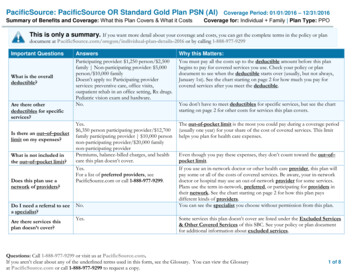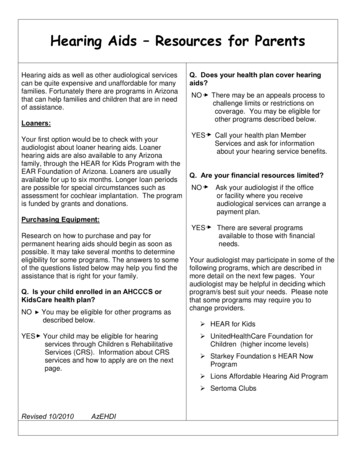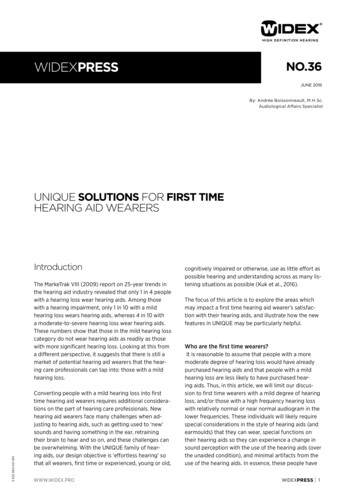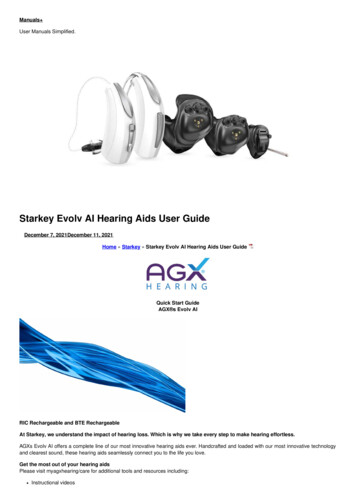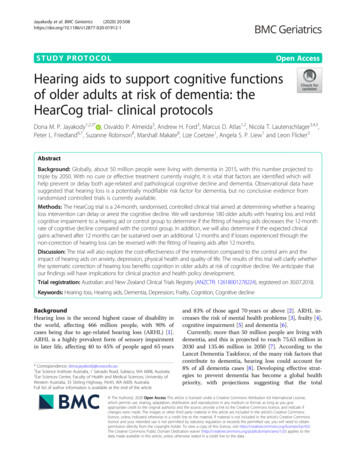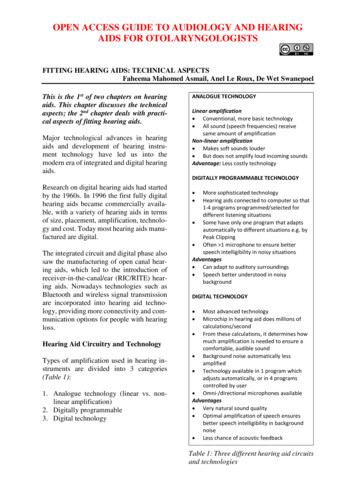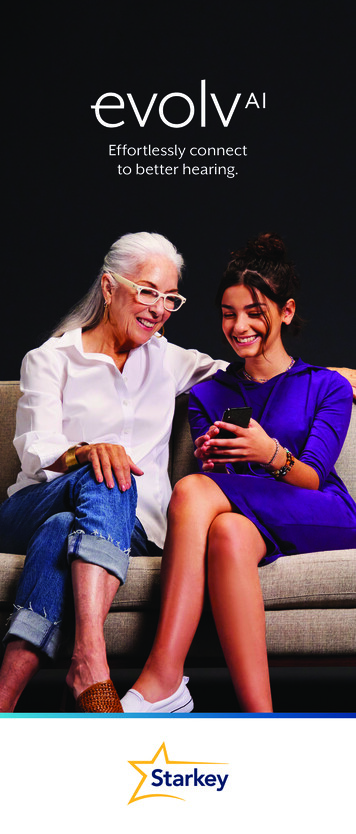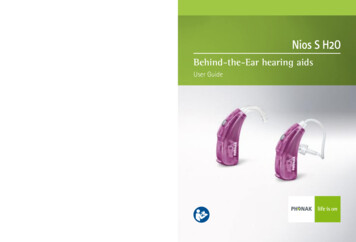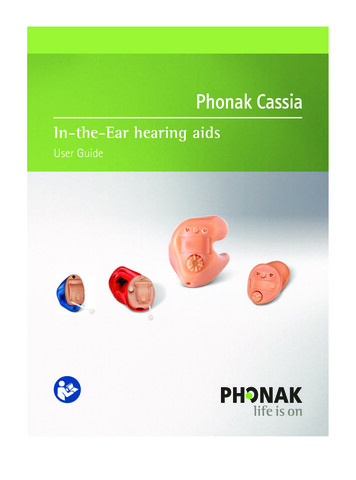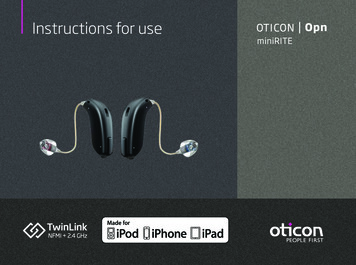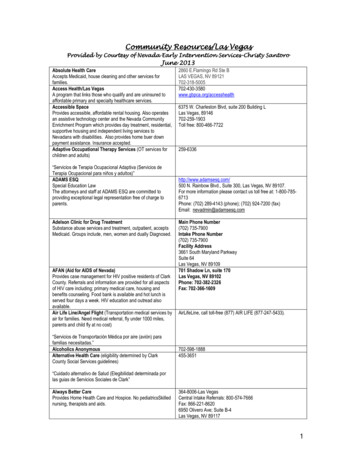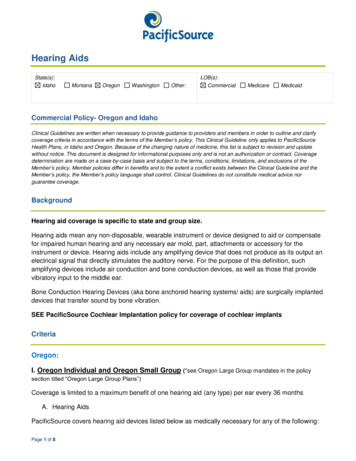
Transcription
Hearing (s):CommercialMedicareMedicaidCommercial Policy- Oregon and IdahoClinical Guidelines are written when necessary to provide guidance to providers and members in order to outline and clarifycoverage criteria in accordance with the terms of the Member’s policy. This Clinical Guideline only applies to PacificSourceHealth Plans, in Idaho and Oregon. Because of the changing nature of medicine, this list is subject to revision and updatewithout notice. This document is designed for informational purposes only and is not an authorization or contract. Coveragedetermination are made on a case-by-case basis and subject to the terms, conditions, limitations, and exclusions of theMember’s policy. Member policies differ in benefits and to the extent a conflict exists between the Clinical Guideline and theMember’s policy, the Member’s policy language shall control. Clinical Guidelines do not constitute medical advice norguarantee coverage.BackgroundHearing aid coverage is specific to state and group size.Hearing aids mean any non-disposable, wearable instrument or device designed to aid or compensatefor impaired human hearing and any necessary ear mold, part, attachments or accessory for theinstrument or device. Hearing aids include any amplifying device that does not produce as its output anelectrical signal that directly stimulates the auditory nerve. For the purpose of this definition, suchamplifying devices include air conduction and bone conduction devices, as well as those that providevibratory input to the middle ear.Bone Conduction Hearing Devices (aka bone anchored hearing systems/ aids) are surgically implanteddevices that transfer sound by bone vibration.SEE PacificSource Cochlear Implantation policy for coverage of cochlear implantsCriteriaOregon:I. Oregon Individual and Oregon Small Group (*see Oregon Large Group mandates in the policysection titled “Oregon Large Group Plans”)Coverage is limited to a maximum benefit of one hearing aid (any type) per ear every 36 monthsA. Hearing AidsPacificSource covers hearing aid devices listed below as medically necessary for any of the following:Page 1 of 8
Conductive hearing loss (external and middle ear blockage/damage/disease) that isunresponsive to medical/surgical interventions OR Sensorineural hearing loss (inner ear cilia are damaged) OR Mixed hearing loss (combination of conduction hearing loss and sensorineural hearing loss).Covered devices used to amplify sound, including advanced signal processing technologies (e.g.,digital signal processing, directional microphones, multiple channels, multiple memories):ooair conduction hearing aid device for the treatment of mild to profound hearing loss: behind the ear (BTE) device, for mild to profound hearing loss in the ear (ITE) device, for mild to moderate hearing loss in the ear canal (ITC) device, for mild to moderate hearing loss completely in the canal (CIC) device, for mild to moderate hearing loss contralateral routing of sound (CROS) device, for single-sided hearing loss (i.e., boneconduction on the hearing side is normal).semi-implantable middle ear hearing aid device when ALL of the following criteria are met: age 18 or older moderate to severe sensorineural hearing loss evidence of a medical condition precluding use of an air conduction aid absence of middle ear diseaseB. Bone Anchored and Bone Conduction Hearing DevicesMust meet MCG A-0564: Hearing Aids, Bone Anchored and Bone Conductionguideline and be over 5 years oldC. Transcutaneously worn Bone Anchored or Bone Conduction Hearing Aid for children under 5years of ageMust meet MCG A-0564: Hearing Aids, Bone Anchored and Bone Conductionguideline and be under 5 years oldApplication of a fully or partially- implantable bone anchored hearing aid utilizing a headband orSoftband is considered medically necessary as an alternative to fully- or partially-implantable boneconduction hearing aid or air conduction hearing aidD. Middle Ear Implantable and Semi-implantable Hearing SystemsMust meet MCG A-0404: Middle Ear Hearing Aids, Implantable and Semi-ImplantableguidelineE. Ear Molds and Replacement Ear MoldsEar molds and replacements ear molds are covered up to 4x per year per ear.F. Over-the-counter hearing assistive devicesPage 2 of 8
Hearing assistive technology systems are covered for members younger than 19 years of age, every 36months, when necessary for appropriate amplification of hearing loss. (eg. frequency modulationsystems, hearing loop, etc.)G. BatteriesOne box of replacement batteries are covered per year for each hearing aid.II. Oregon Large Group PlansThe following mandates apply to Oregon Large Group Plans only:Coverage is limited to a maximum benefit of one hearing aid per ear every 36 months for members 18years of age and younger and 19-25 (if enrolled in school)A. Hearing Aids One hearing aid per hearing impaired ear every 36 months or more frequently if modifications toan existing hearing aid will not meet the needs of a member who is 18 years of age or youngeror is 19 to 25 years of age (enrolled in a secondary school or an accredited educationalinstitution).One box of replacement batteries per year for each hearing aid.B. Ear Molds and Replacement Ear MoldsEar molds are covered for the following: Members younger than 8 years of age are covered for four ear molds per plan year Members 8 to 18 years of age or are 19-25 (enrolled in a secondary school or accreditededucational institution are covered for one ear mold per plan yearC. Hearing assistive devicesHearing assistive technology systems are covered for members younger than 19 years of age, every 36months, when necessary for appropriate amplification of the hearing loss. (eg. hearing loop, frequencymodulation system ect.)IdahoIdaho Individual, Small Group, Large Group Plans:A. Hearing Aids Member must be age 26 years or youngerLimit of one hearing aid per hearing impaired ear every 36 months45 speech therapy visits over 12 months post initiation of a hearing deviceB. Bone Anchored and Bone Conduction Hearing DevicesMust meet MCG A-0564: Hearing Aids, Bone Anchored and Bone Conduction guideline and beover 5 years old.C. Transcutaneously worn Bone Anchored or Bone Conduction Hearing Aid for childrenunder 5 years of age.Must meet MCG A-0564: Hearing Aids, Bone Anchored and Bone Conduction guideline and bePage 3 of 8
under 5 years oldApplication of a fully or partially-implantable bone anchored hearing aid utilizing a headband orSoftband is considered medically necessary as an alternative to fully- or partially-implantable boneconduction hearing aid or air conduction hearing aidD. Middle Ear Implantable and Semi-implantable Hearing SystemsMust meet MCG A-0404: Middle Ear Hearing Aids, Implantable and Semi-implantableguidelineCoding InformationCPT codes69714 Implantation, Osseointegrated Implant Temporal Bone; W/O Mastoidectomy69715 Implantation, Osseointegrated Implant, Temporal Bone; W/Mastoidectomy69717 Replacement, Osseointegrated Implant, Temporal Bone; W/O Mastoidectomy69718 Replacement, Osseointegrated Implant, Temporal Bone; W/MastoidectomyHCPC codesL8625 External recharging system for battery for use with cochlear implant or auditory osseointegrateddevice, replacement only, eachL8690 Auditory osseointegrated device, includes all internal and external componentsL8691 Auditory osseointegrated device, external sound processor, excludes transducer/actuator,replacement only, eachL8693 Auditory osseointegrated device abutment, any length, replacement onlyL8694 Auditory osseointegrated device, transducer/actuator, replacement only, eachS2230 Implantation of magnetic component of semi-implantable hearing device on ossicles in middleearV5014 Repair/modification of a hearing aidV5030 Hearing aid, monaural, body worn, air conductionV5040 Hearing aid, monaural, body worn, air conductionV5050 Hearing aid, monaural, in the earV5060 Hearing aid, monaural, behind the earV5070 Glasses, air conductionV5080 Glasses, bone conductionPage 4 of 8
V5095 Semi-implantable middle ear hearing prosthesisV5100 Hearing aid, bilateral, body wornV5120 Binaural, bodyV5130 Binaural, in the earV5140 Binaural, behind the earV5150 Binaural, glasses (contained in a pair of glasses)V5170 Hearing aid, CROS, in‐the‐ear (includes both the receiver and the transmitter)V5180 Hearing aid, CROS, behind‐the‐ear (includes both the receiver and the transmitter)V5190 Hearing aid, CROS, glasses (contained in pair of eyeglasses)V5210 Hearing aid, BICROS, in‐the‐ear (includes both the transmitter and the hearing aid/receiver)V5220 Hearing aid, BICROS, behind‐the‐ear (includes transmitter and the hearing aid/receiver)V5230 Hearing aid, BICROS, glasses (contained in pair of eyeglasses)V5242 Hearing aid, analog, monaural, CICV5243 Hearing aid, analog, monaural, ITCV5244 Hearing aid, digitally programmable analog, monaural, CICV5245 Hearing aid, digitally programmable, analog, monaural, ITCV5246 Hearing aid, digitally programmable, analog, monaural, ITEV5247 Hearing aid, analog, digitally programmable, monaural, BTEV5248 Hearing aid, analog, binaural, CICV5249 Hearing aid, analog, binaural, ITCV5250 Hearing aid, digitally programmable analog, binaural, CICV5251 Hearing aid, digitally programmable, analog, binaural, ITCV5252 Hearing aid, digitally programmable, analog, binaural, ITEV5253 Hearing aid, analog, digitally programmable, binaural, BTEV5254 Hearing aid, digital, monaural, CICV5255 Hearing aid, digital, monaural, ITCV5256 Hearing aid, digital, monaural, ITEV5257 Hearing aid, digital, monaural, BTEV5258 Hearing aid, digital, binaural, CICPage 5 of 8
V5259 Hearing aid, digital, binaural, ITCV5260 Hearing aid, digital, binaural, ITEV5261 Hearing aid, digital, binaural, BTEV5262 Hearing aid, disposable, any type, monauralV5263 Hearing aid, disposable, any type, binauralV5264 Ear mold insert, not disposable, any typeV5265 Ear mold insert, Earmold/insert disposable, any typeV5298 Hearing aid, not otherwise classifiedDefinitionsAnalog aids: convert sound waves into electrical signals, which are amplified. Analog/adjustablehearing aids are custom built to meet the needs of each user. The aid is programmed by themanufacturer according to the specifications recommended by the audiologist. Analog/programmablehearing aids have more than one program or setting. Analog aids are a relatively inexpensive option.However, analog hearing aids are being replaced by digital technology.Audiometric testing: Diagnostic tests that evaluate the ability to hear sounds. The intensity (loudness)of sound is measured in decibels. The tone (speed of sound wave vibrations) is measured in cycles persecond. The standard battery of hearing tests varies depending on whether the patient is an infant,child or adult.Behind-the-ear (BTE): hearing aids consist of a hard plastic case worn behind the ear and connectedto a plastic earmold that fits inside the outer ear. The electronic parts are held in the case behind theear. Sound travels from the hearing aid through the earmold and into the ear. BTE aids are used bypeople of all ages for mild to profound hearing loss.Completely in the ear canal (CIC): is molded to fit inside your ear canal. It improves mild to moderatehearing loss in adults.Canal aids: fit into the ear canal and are available in two styles. The in-the-canal (ITC) hearing aid ismade to fit the size and shape of a person’s ear canal. A completely-in-canal (CIC) hearing aid is nearlyhidden in the ear canal. Both types are used for mild to moderately severe hearing loss.Digital aids: convert sound waves into numerical codes, similar to the binary code of a computer,before amplifying them. This technology is more flexible with options for fine tuning the hearing aid tothe member’s hearing needs by the audiologist and user.Digital hybrid hearing aids: have both analog technology for sound processing and digital technologyfor programming. Hybrid aids offer more options for the audiologist and user to adjust the “channels” tomeet a variety of listening environments.Hearing assistive (per House Bill 1404) technology systems are devices used with or withouthearing aids or cochlear implants to improve the ability of a user with hearing loss to hear in variousPage 6 of 8
listening situations, such as being located a distance from a speaker, in an environment with competingbackground noise or in a room with poor acoustics or reverberation.Hearing impairment (deafness/hearing loss): A reduction in the ability to perceive sound that isclassified as mild, moderate, severe or profound.Hearing loss: is described as conductive, sensorineural, or mixed, and can be unilateral or bilateral.The American Speech - Language - Hearing Association (ASHA) has defined the degree of hearingloss based on pure-tone average (PTA). The PTA is the average air-conduction threshold for 1000 and2000 Hz, and 3000 Hz measured with an earphone. Normal hearing is the detection of sound at orbelow 20 decibels (dB).Hearing assistive (per House Bill 1404) technology systems are devices used with or withouthearing aids or cochlear implants to improve the ability of a user with hearing loss to hear in variouslistening situations, such as being located a distance from a speaker, in an environment with competingbackground noise or in a room with poor acoustics or reverberationIn-the-ear (ITE): hearing aids fit completely inside the outer ear and are used for mild to severe hearingloss. The case holding the electronic components is made of hard plastic. Some ITE aids may havecertain added features installed, such as a telecoil. A telecoil is a small magnetic coil that allows usersto receive sound through the circuitry of the hearing aid, rather than through its microphone. Thismakes it easier to hear conversations over the telephone. A telecoil also helps people hear in publicfacilities that have installed special sound systems, called induction loop systems. Induction loopsystems can be found in many churches, schools, airports, and auditoriums. ITE aids usually are notworn by young children because the casings need to be replaced often as the ear grows.In the canal (ITC): hearing aid is custom molded and fits partly in the ear canal. This style can improvemild to moderate hearing loss in adults.Open fit: An open-fit hearing aid is a variation of the behind-the-ear hearing aid with a thin tube. Thisstyle keeps the ear canal very open, allowing for low-frequency sounds to enter the ear naturally andfor high-frequency sounds to be amplified through the hearing aid. This makes the style a good choicefor people with mild to moderate hearing loss.Pure tone average (PTA): Average air conduction threshold measured with an earphone.Receiver in canal or receiver in the ear: The receiver-in-canal (RIC) and receiver-in-the-ear (RITE)styles are similar to a behind-the-ear hearing aid with the speaker or receiver in the canal or in the ear.A tiny wire, rather than tubing, connects the pieces.Traditional hearing aid: A non-implanted, non-disposable on-ear or in-ear device that is FDAapproved and dispensed only by prescription.Related PoliciesCase Manager Determinations on Non-coverageCochlear ImplantationPage 7 of 8
ReferencesNational Institute on Deafness and Other Communication Disorders (NIDCD). Hearing Aids, NIH Pub.No.13-4340. Updated March 6, 2017, Accessed -aidsAppendixPolicy Number: [PolicyNumber]Effective: 1/1/2020Next review: 1/1/2021Policy type: CommercialDepts: Health ServicesApplicable regulation(s): OAR 836-053-0012(3) (C), OAR 836-053-1404 ORS 743A.140; ORS 743A.141External entities affected: N/APage 8 of 8
Hearing aid coverage is specific to state and group size. Hearing aids mean any non-disposable, wearable instrument or device designed to aid or compensate for impaired human hearing and any necessary ear mold, part, attachments or accessory for the instrument or device. Hearing aids include any amplifying device that does not produce as its .
